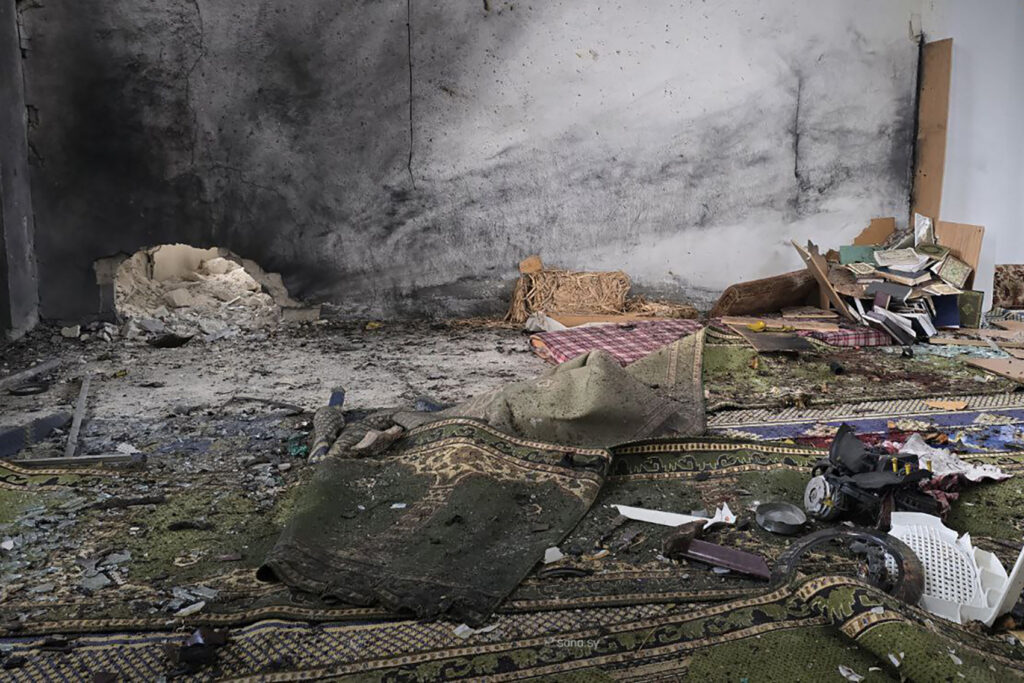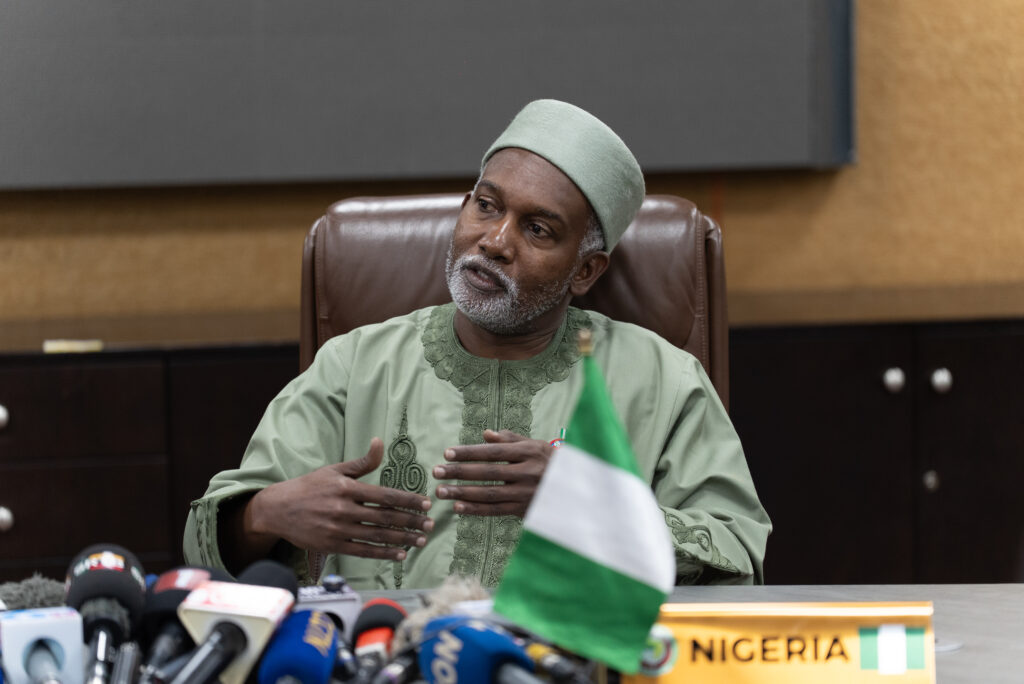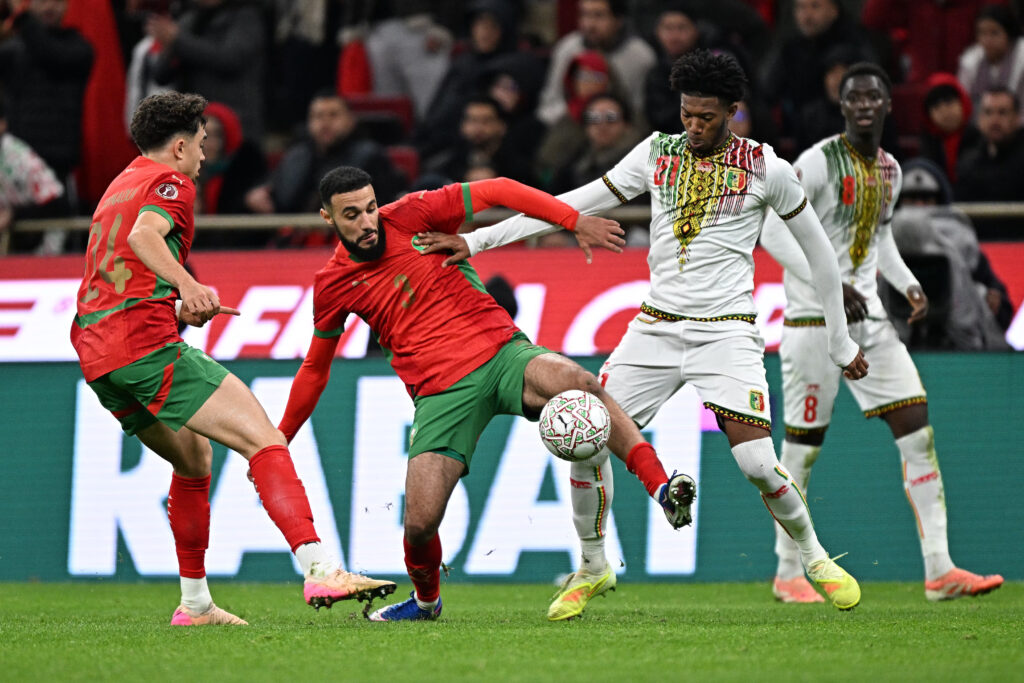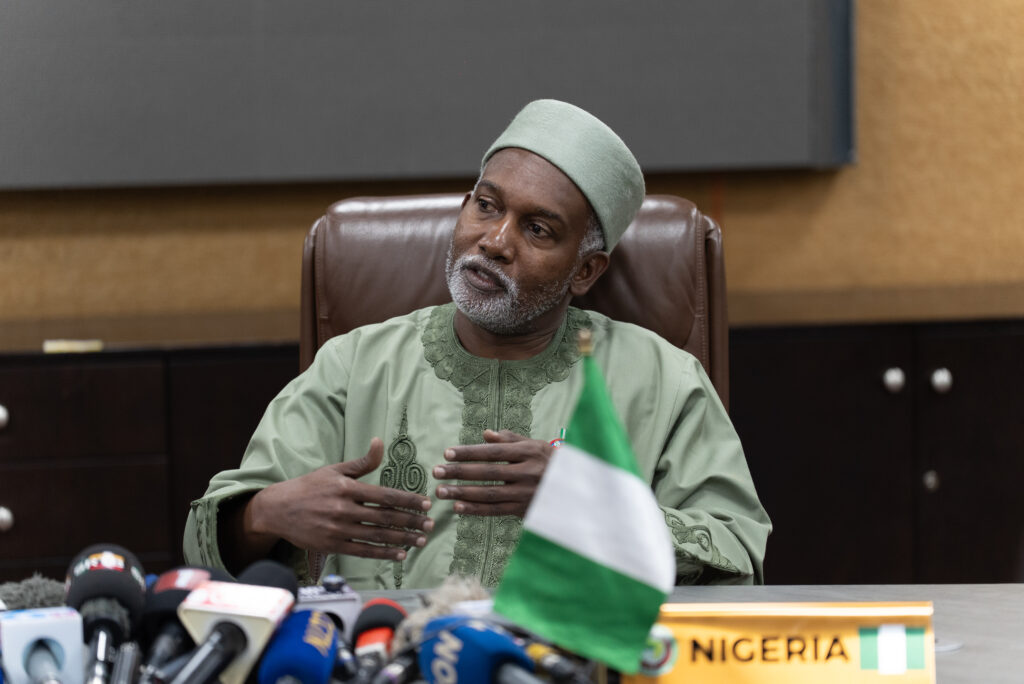En Syrie, une attaque dans une mosquée en secteur alaouite fait huit morts
Une explosion a frappé vendredi une mosquée située dans un secteur alaouite de la ville de Homs en Syrie, faisant huit morts, dernière attaque en date visant cette communauté musulmane minoritaire dans le pays.Il s’agit du deuxième attentat de ce type dans un lieu de culte fréquenté par des minorités depuis qu’une coalition de groupes …
En Syrie, une attaque dans une mosquée en secteur alaouite fait huit morts Read More »
Le Nigeria évoque d’autres frappes dans le cadre d’opérations “conjointes” avec les États-Unis
Le Nigeria a laissé entendre que d’autres frappes contre les groupes jihadistes étaient à prévoir après celles menées le jour de Noël par les forces américaines dans le nord du pays, durant lesquelles toutes les cibles visées “ont été décimées”, selon Donald Trump vendredi.”Tous les camps” jihadistes visés par l’armée américaine lors de frappes au …
Trois femmes légèrement blessées au couteau dans le métro parisien, le suspect interpellé
Trois femmes ont été légèrement blessées au couteau vendredi après-midi dans le métro parisien par un homme qui a pris la fuite avant d’être interpellé en banlieue parisienne.Les agressions ont eu lieu aux stations desservies par la ligne 3, Arts et Métiers, République et Opéra, au centre de Paris, “entre 16H15 et 16H45”, a expliqué à l’AFP l’opérateur public des transports parisiens (RATP).L’auteur présumé, âgé de 25 ans, a été identifié “grâce aux images de vidéosurveillance”. Il était déjà connu des services de police pour divers faits dont des atteintes aux biens, a expliqué le parquet de Paris.”La mise en œuvre de la géolocalisation de son téléphone portable a permis son interpellation en fin d’après-midi dans le Val-d’Oise”, a-t-il ajouté.Une enquête, confiée aux services de la sûreté régionale des transports (SRT), a été ouverte pour tentative d’homicide volontaire et violences volontaires avec arme.Selon la préfecture de police de Paris, le suspect a été interpellé “à 18h55 par le service enquêteur assisté des policiers du Val-d’Oise”.”De nationalité malienne, en situation irrégulière sur le territoire national, cet individu, déjà connu pour destruction de biens sous l’emprise de stupéfiants, a été écroué en janvier 2024 pour vol aggravé et agression sexuelle après avoir été condamné pénalement”, indique le ministère de l’Intérieur dans un communiqué. Libéré en juillet, “il a fait l’objet d’une obligation de quitter le territoire français (OQTF) et a été placé en centre de rétention administrative”, ajoute Beauvau. “L’éloignement n’ayant pu aboutir dans le délai légal des 90 jours, faute d’obtention d’un laisser-passer consulaire en l’absence de titre d’identité valide, il a été libéré avec assignation à résidence”, poursuit-on, précisant qu'”il était actuellement sous mandat de recherche”.Le ministre de l’Intérieur, Laurent Nuñez, “regrette que l’éloignement du suspect n’ait pu aboutir” et assure que “la mobilisation se poursuit pour parvenir, en priorité, à éloigner des étrangers en situation irrégulière auteurs de troubles à l’ordre public”. Deux des “victimes ont été prises en charge par les secours et transportées en milieu hospitalier sans pronostic vital engagé”, tandis que la troisième s’est présentée elle-même à l’hôpital, a indiqué la préfecture de police.Le préfet de police de Paris Patrice Faure a précisé, sur X, que les trois victimes “avaient été légèrement blessées”.Un journaliste de l’AFP a vu sur un quai de la ligne 3 à la station République une femme prise en charge par une équipe de sécurité. Elle était blessée à la jambe et visiblement choquée.- “Vigilance maximale” -Laurent Nuñez a “félicit(é) les enquêteurs et policiers” qui ont identifié puis interpellé le suspect “notamment grâce au réseau de caméras de vidéoprotection et à leur connaissance exceptionnelle du terrain”.Le préfet de police a, lui, salué “la réactivité et la mobilisation de ses services”, tout comme l’a fait la présidente de la Région Ile-de-France, Valérie Pécresse, également présidente d’Ile-de-France Mobilités, le réseau de transport de la région parisienne.”Avec la loi sur la sûreté dans les transports que j’ai portée, un arsenal juridique et opérationnel se déploie pour renforcer la sécurité: caméras-piétons pour les agents, saisie des objets dangereux, interdiction d’entrée en gare pour les personnes qui troublent l’ordre public et interdictions de paraître pour les personnes déjà condamnées”, a rappelé sur X le ministre des Transports, Philippe Tabarot.Des équipes de sécurité ont “été déployées en renfort pour sécuriser la ligne” 3, selon la RATP.Laurent Nuñez avait appelé la semaine passée les préfets et responsables de la sécurité à “une vigilance maximale” à l’approche des festivités du Nouvel an dans un télégramme consulté par l’AFP, notamment en raison “du niveau très élevé de la menace terroriste”.Il avait notamment souhaité qu'”une attention spécifique” soit portée “aux transports en commun”.neo-emd-cco-mk/asl/ms
Trois femmes légèrement blessées au couteau dans le métro parisien, le suspect interpellé
Trois femmes ont été légèrement blessées au couteau vendredi après-midi dans le métro parisien par un homme qui a pris la fuite avant d’être interpellé en banlieue parisienne.Les agressions ont eu lieu aux stations desservies par la ligne 3, Arts et Métiers, République et Opéra, au centre de Paris, “entre 16H15 et 16H45”, a expliqué à l’AFP l’opérateur public des transports parisiens (RATP).L’auteur présumé, âgé de 25 ans, a été identifié “grâce aux images de vidéosurveillance”. Il était déjà connu des services de police pour divers faits dont des atteintes aux biens, a expliqué le parquet de Paris.”La mise en œuvre de la géolocalisation de son téléphone portable a permis son interpellation en fin d’après-midi dans le Val-d’Oise”, a-t-il ajouté.Une enquête, confiée aux services de la sûreté régionale des transports (SRT), a été ouverte pour tentative d’homicide volontaire et violences volontaires avec arme.Selon la préfecture de police de Paris, le suspect a été interpellé “à 18h55 par le service enquêteur assisté des policiers du Val-d’Oise”.”De nationalité malienne, en situation irrégulière sur le territoire national, cet individu, déjà connu pour destruction de biens sous l’emprise de stupéfiants, a été écroué en janvier 2024 pour vol aggravé et agression sexuelle après avoir été condamné pénalement”, indique le ministère de l’Intérieur dans un communiqué. Libéré en juillet, “il a fait l’objet d’une obligation de quitter le territoire français (OQTF) et a été placé en centre de rétention administrative”, ajoute Beauvau. “L’éloignement n’ayant pu aboutir dans le délai légal des 90 jours, faute d’obtention d’un laisser-passer consulaire en l’absence de titre d’identité valide, il a été libéré avec assignation à résidence”, poursuit-on, précisant qu'”il était actuellement sous mandat de recherche”.Le ministre de l’Intérieur, Laurent Nuñez, “regrette que l’éloignement du suspect n’ait pu aboutir” et assure que “la mobilisation se poursuit pour parvenir, en priorité, à éloigner des étrangers en situation irrégulière auteurs de troubles à l’ordre public”. Deux des “victimes ont été prises en charge par les secours et transportées en milieu hospitalier sans pronostic vital engagé”, tandis que la troisième s’est présentée elle-même à l’hôpital, a indiqué la préfecture de police.Le préfet de police de Paris Patrice Faure a précisé, sur X, que les trois victimes “avaient été légèrement blessées”.Un journaliste de l’AFP a vu sur un quai de la ligne 3 à la station République une femme prise en charge par une équipe de sécurité. Elle était blessée à la jambe et visiblement choquée.- “Vigilance maximale” -Laurent Nuñez a “félicit(é) les enquêteurs et policiers” qui ont identifié puis interpellé le suspect “notamment grâce au réseau de caméras de vidéoprotection et à leur connaissance exceptionnelle du terrain”.Le préfet de police a, lui, salué “la réactivité et la mobilisation de ses services”, tout comme l’a fait la présidente de la Région Ile-de-France, Valérie Pécresse, également présidente d’Ile-de-France Mobilités, le réseau de transport de la région parisienne.”Avec la loi sur la sûreté dans les transports que j’ai portée, un arsenal juridique et opérationnel se déploie pour renforcer la sécurité: caméras-piétons pour les agents, saisie des objets dangereux, interdiction d’entrée en gare pour les personnes qui troublent l’ordre public et interdictions de paraître pour les personnes déjà condamnées”, a rappelé sur X le ministre des Transports, Philippe Tabarot.Des équipes de sécurité ont “été déployées en renfort pour sécuriser la ligne” 3, selon la RATP.Laurent Nuñez avait appelé la semaine passée les préfets et responsables de la sécurité à “une vigilance maximale” à l’approche des festivités du Nouvel an dans un télégramme consulté par l’AFP, notamment en raison “du niveau très élevé de la menace terroriste”.Il avait notamment souhaité qu'”une attention spécifique” soit portée “aux transports en commun”.neo-emd-cco-mk/asl/ms
Morocco made to wait for Cup of Nations knockout place after Egypt advanceFri, 26 Dec 2025 22:42:38 GMT
Hosts Morocco missed the chance to secure qualification for the knockout phase of the Africa Cup of Nations after drawing 1-1 with Mali on Friday, but Mohamed Salah’s penalty gave Egypt a 1-0 win over South Africa which took them through to the last 16.The Group A clash between Morocco and Mali at the Prince …
Le Nigeria évoque d’autres frappes dans le cadre d’opérations “conjointes” avec les États-Unis
Le Nigeria a laissé entendre que d’autres frappes contre les groupes jihadistes étaient à prévoir après celles menées le jour de Noël par les forces américaines dans le nord du pays, durant lesquelles toutes les cibles visées “ont été décimées”, selon Donald Trump vendredi.”Tous les camps” jihadistes visés par l’armée américaine lors de frappes au Nigeria ont été “décimés”, a déclaré le président américain au média Politico. “J’ai dit (…) +donnons leur un cadeau de Noël+ (…) Ils ne voyaient pas ça venir, mais on les a frappés fort”, a-t-il affirmé.Ces frappes ont eu lieu après qu’Abuja et Washington se sont retrouvés dans une impasse diplomatique au sujet de ce que le président américain Donald Trump a qualifié de massacre de chrétiens, dans le contexte des innombrables conflits armés qui secouent le Nigeria.Interrogé sur la possibilité de nouvelles frappes, le ministre nigérian des Affaires étrangères Yusuf Tuggar a répondu à la chaîne de télévision locale ChannelsTV: “C’est un processus en cours, et nous travaillons avec les États-Unis. Nous collaborons également avec d’autres pays”.”C’est le Nigeria qui a fourni les renseignements” à Washington, a-t-il dit, précisant s’être entretenu au téléphone avec le secrétaire d’État américain Marco Rubio à deux reprises avant l’attaque.Un responsable américain a lui confirmé que le Pentagone avait “collaboré avec le gouvernement du Nigeria pour mener ces frappes”.Mais la relation ne semble pas sans difficultés: Washington a refusé de publier un communiqué commun entre les deux pays, a affirmé le ministre Yusuf Tuggar.Le Nigeria est confronté à plusieurs crises sécuritaires interdépendantes, avec des jihadistes menant une insurrection dans le nord-est depuis 2009 et des gangs armés pillant des villages et organisant des enlèvements dans le nord-ouest.- “Tout le monde a eu peur” -On ignore encore quelles cibles, parmi les nombreux groupes armés du Nigeria, ont été visées, ni comment l’opération s’est précisément déroulée.Une vidéo d’une dizaine de secondes publiée par le ministère américain de la Défense sur X semble montrer le lancement, de nuit, d’un missile depuis le pont d’un navire de guerre battant pavillon américain.De son côté, le ministre nigérian de l’Information affirme que 16 “munitions” ont été larguées par des drones MQ-9 Reaper. Les habitants des villages reculés de l’État de Sokoto, qui borde le Niger dirigé par la junte, se sont dits choqués par les frappes. “Nous avons entendu une forte explosion qui a secoué toute la ville et tout le monde a eu peur”, a déclaré Haruna Kallah, un habitant de Jabo, à environ 100 kilomètres de la capitale de l’État, Sokoto, dans le district de Tambuwal. “Au début, nous avons pensé qu’il s’agissait d’une attaque de Lakurawa”, un groupe armé lié à l’État islamique au Sahel, a ajouté ce témoin, qui s’est dit “surpris car nous n’avons jamais été une enclave de Lakurawa et nous n’avons jamais subi d’attaques ces deux dernières années”.- “Trump n’aurait pas accepté un refus” -Ces assauts marquent la première intervention militaire américaine dans le pays le plus peuplé d’Afrique sous Donald Trump. Affirmant que les chrétiens y étaient sous une “menace existentielle” de l’ordre d’un “génocide”, il avait menacé le mois dernier de recourir à l’option armée.Le gouvernement nigérian et des analystes indépendants refusent de parler de persécution religieuse, un argument longtemps utilisé par la droite chrétienne aux États-Unis, en Europe et par des séparatistes nigérians qui conservent une influence à Washington.Face à la pression diplomatique, les autorités nigérianes tiennent à montrer qu’elles coopèrent avec les États-Unis, estime auprès de l’AFP Malik Samuel, un analyste basé à Abuja pour l’ONG Good Governance Africa. Il ajoute que les auteurs des attaques “et les victimes dans le nord-ouest sont en grande majorité musulmans”.Le Nigeria est divisé de manière à peu près égale entre le sud à majorité chrétienne et le nord à majorité musulmane. Il est le théâtre de nombreux conflits qui tuent aussi bien des chrétiens que des musulmans, souvent sans distinction. bur-tba-sn-nro/vla/ube






